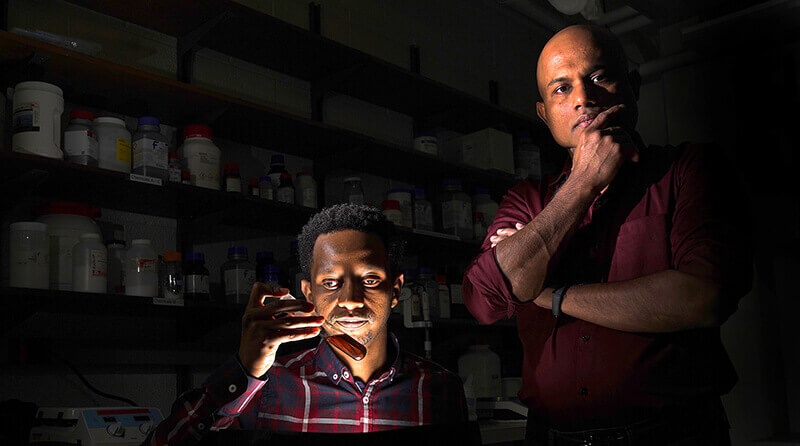A delicate balance of electrons flowing through the photosynthetic machinery is essential to a plant’s ability to turn sunlight into energy and its survival. Understanding the factors that regulate this balance is key for plant breeders who may want to improve light energy conversion in crop plants for increased yield.
Scientists know that a particular protein is responsible for regulating gene expression of photosystems in response to perturbations in photosynthetic electron flow, but how it senses the electrons has been an unresolved question. Purdue University scientists Sujith Puthiyaveetil and Iskander Ibrahim believe they have the answer.
Ibrahim, a postdoctoral researcher in the Puthiyaveetil laboratory, and Puthiyaveetil, an assistant professor of biochemistry and a member of Purdue’s Center for Plant Biology, with colleagues William A. Cramer, Purdue’s Henry Koffler Distinguished Professor of Biological Sciences, Yulia Pushkar, a professor of physics and astronomy, and W. Andy Tao, a professor of biochemistry, have shown that the chloroplast sensor kinase (CSK) protein is equipped with an evolutionarily conserved iron-sulfur cluster. The cluster helps it to sense the presence of electrons and thereby send signals to the gene expression machinery in plant chloroplasts to turn photosystem genes on and off.
“CSK is an ancient protein found in both cyanobacteria and chloroplasts. More than a billion years ago a cyanobacterium took up residence inside a eukaryotic host cell and became the chloroplast of plants and algae,” Puthiyaveetil said. “By examining the cyanobacterial, plant and diatom CSK proteins, we’ve discovered that CSK uses an iron-sulfur cluster to sense the electron transport, assessing how well the electrons are flowing, and make adjustments in the relative abundance of plant photosystems to keep photosynthesis working correctly and protect the plant from oxidative stress.”
The scientists were tipped off to the potential of the metallic cluster by CSK’s brownish color.
“When we stumbled upon the brown color, we knew we were a step closer to deciphering the molecular language that CSK uses to talk to the photosynthetic electron transport chain,” said Ibrahim, lead author of the findings published in the journal Communications Biology. “The brown hue of the CSK protein originates from its iron-sulfur cluster. Iron-sulfur clusters are known to play important roles in conducting the electron transport reactions of life.”
During photosynthesis, plants turn sunlight into energy via two photosystems. Photosystem I utilizes long wavelength light efficiently while photosystem II prefers mostly short wavelength light, with the two photosystems connected by the plastoquinone pool. As the systems work, photosystem II sends electrons into the plastoquinone pool while photosystem I removes and utilizes them.
But if a plant is exposed to shorter wavelength light, the electron balance can be lost. In that case, photosystem II would send electrons into the plastoquinone pool, but photosystem I wouldn’t be able to draw them efficiently. Those electrons could linger in the plastoquinone pool and produce dangerous free radicals.
“The two photosystems are like two photovoltaic cells connected in series,” Puthiyaveetil said. “They should convert light energy at equal rates for optimal electron transport. If the electron transport is not balanced, you get free radicals that can damage the plant’s photosynthetic machinery and hurt or kill the plant.”
Purdue scientists determined that CSK’s iron-sulfur cluster acts as a sort of magnet for those extra electrons. When the plastoquinone pool becomes reduced, meaning it has excess electrons, those electrons leak into CSK and turn off its kinase activity.
When kinase activity is interrupted, CSK stops transferring phosphate groups to the chloroplast gene expression machinery, turning on photosystem I genes and increasing its amount and therefore activity in short wavelength light. In essence, when CSK’s kinase activity is on, it serves as a brake pedal for photosystem I gene expression.
The CSK is redox-reactive, meaning it’s using the iron and sulfur to sense the electron flow, and that’s keeping the two photosystems working at the same rate in photosynthesis.
The findings illuminate an elegant regulatory mechanism in the photosynthetic processes of plants. It’s possible, Puthiyaveetil said, that one day this regulatory circuit could be modified to increase photosynthetic efficiency in crop plants by improving light capture in shaded conditions.
The U.S. Department of Energy, the National Science Foundation, and the Showalter Trust supported the research.
 Noticing the protein's brown color, Iskander Ibrahim and Sujith Puthiyaveetil (right) determined that CSK contains an iron-sulfur cluster that senses electron transport during photosynthesis. The CSK protein plays a key role in balancing light energy conversion by cyanobacteria and chloroplasts. (Purdue Agricultural Communication photo/Tom Campbell).
Noticing the protein's brown color, Iskander Ibrahim and Sujith Puthiyaveetil (right) determined that CSK contains an iron-sulfur cluster that senses electron transport during photosynthesis. The CSK protein plays a key role in balancing light energy conversion by cyanobacteria and chloroplasts. (Purdue Agricultural Communication photo/Tom Campbell). 




